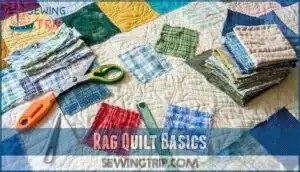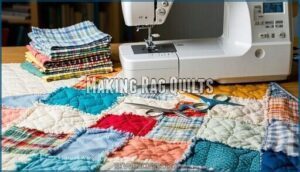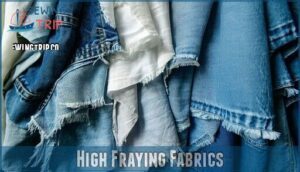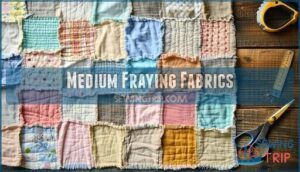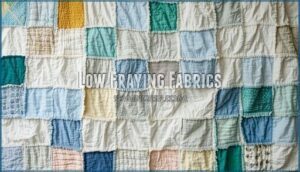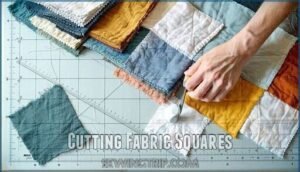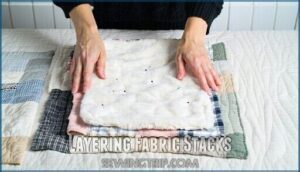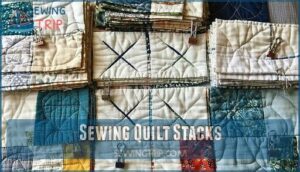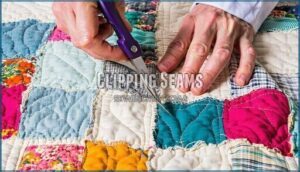This site is supported by our readers. We may earn a commission, at no cost to you, if you purchase through links.
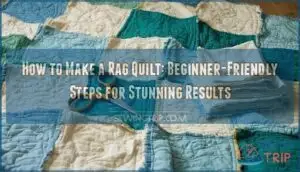 Making a rag quilt is simple and satisfying. Start by choosing soft fabrics like flannel or cotton that fray easily.
Making a rag quilt is simple and satisfying. Start by choosing soft fabrics like flannel or cotton that fray easily.
Cut them into uniform squares, then stack each one with a middle batting layer and backing fabric. Sew an “X” across each stack to secure the layers.
Arrange the squares into your quilt design, sew rows together, and attach the rows. Clip the seams to create the “ragged” effect, being careful not to snip through your stitching.
Afterward, toss the quilt in the washer and dryer to fluff those edges. It’s as cozy as it gets, and surprisingly beginner-friendly!
Table Of Contents
Key Takeaways
- Choose fray-friendly fabrics like flannel or denim for soft, textured edges, and prewash them to prevent shrinking.
- Layer fabrics with exposed seams, sew an “X” through each stack for stability, and join rows using a ½-inch seam allowance.
- Clip seams every ¼ to ½ inch without cutting stitches to create the frayed effect after washing.
- Skip binding by sewing around the edges, then wash and dry the quilt to fluff up the seams for a cozy finish.
Rag Quilt Basics
A rag quilt is made by layering fabrics with exposed seams that fray beautifully after washing, giving it a soft, textured look.
Layer fabrics with exposed seams for a cozy, textured quilt that softens and frays beautifully after its first wash.
It’s a simple process that skips traditional quilting steps, making it perfect for beginners who want quick, cozy results.
Characteristics of Rag Quilts
Rag quilts are all about cozy charm and simplicity.
Their frayed edge quilt design highlights exposed seams that fray beautifully, creating a soft texture after washing.
With a typical layer count of two to four fabrics, they bring warmth and character, and the Bohemian style adds flair, while the speed factor makes completing a rag quilt pattern a breeze!
History of Rag Quilts
The history of rag quilts is as textured as the quilts themselves.
Originating in the 1700s, settlers crafted them from fabric scraps, blending necessity with creativity.
Early techniques included hand-poked fabric strips for insulation.
Quilting became a cherished tradition, evolving into an art form with cultural significance, showcasing handmade quilts that reflect regional variations and the resilience of quilt traditions.
These quilts are known for their frayed and raw edges which gives them their unique look, making them a testament to regional variations and the resilience of quilt traditions.
Benefits of Rag Quilts
A fabric scrap quilt made using rag quilting offers so many perks.
It’s a cozy, comfy quilt with a unique style that stands out. It’s perfect as a beginner quilt project, quick to complete, and cost-effective too.
Plus, there’s creative freedom to mix fabrics and create something truly yours.
- Warm texture: Layers create a snug, cozy comfort.
- Great for beginners: An easy quilt with forgiving seams.
- Budget-friendly: Use leftover fabric scraps for originality.
Making Rag Quilts
Making a rag quilt is easier than you’d think, especially when you follow straightforward rag quilt instructions. Start by ensuring you’ve got the right tools.
Use a sewing machine with a 90/14 needle size—tough enough for layers. A walking foot helps manage fabric weight smoothly.
For each quilt stack, layer your fabrics: backing (wrong side down), middle layer, and top (right side up). Mark an "X" on each stack and sew along it for stability.
When joining stacks, sew with a 1/2" seam allowance, leaving edges exposed—it’s key to those fluffy, frayed seams. Remember to prewash your fabrics to avoid shrinking after the quilt is assembled.
Don’t skip sharp scissors; they’re essential for easy fraying techniques. It’s a beginner quilt project that’s both fun and forgiving—a stress-free way to get started with quilting!
Choosing Fabrics
Choosing fabrics is all about balancing style with function, so think about how much fraying you want and what textures you’ll enjoy.
Stick to a mix of high, medium, and low fraying fabrics to create a durable quilt with that perfect fluffy edge.
High Fraying Fabrics
When picking high fraying fabrics for your rag quilt, think Denim Durability, Flannel Softness, Silk Elegance, Chiffon Sheerness, or Satin Drape.
These options provide the perfect balance for fraying, giving your quilt the right mix of texture and flair.
Natural fibers fray beautifully, adding character to each stitch.
Consider various weights and weaves for unique textures.
Skip synthetics—they fray less, making them less exciting here.
Experiment and enjoy with complete concepts and unique textures to create a quilt that showcases natural fibers.
Medium Fraying Fabrics
Medium fraying fabrics strike a balance between strength and style.
Quilting cotton adds charm with its soft feel and high thread count.
Linen’s durability guarantees long-lasting seams, while sateen offers a luxurious touch.
Cotton blends are versatile, offering consistent fraying for a polished rag quilt look.
Fabric selection criteria guarantees the right material is used for the project.
These fabrics fray just enough to create texture without overwhelming the quilt’s design.
Low Fraying Fabrics
If you’re considering low fraying fabrics for your rag quilt, think fleece options, stretch materials, and polyester blends.
These fabrics avoid excessive edge fraying, making them great for edge finishing and durability concerns.
While they won’t give you a fluffy texture like high fraying fabrics, they offer smoothness and stability, perfect for backing layers in your fabric selection.
Assembling Quilt Stacks
To assemble your quilt stacks, layer the fabrics in the correct order: bottom side down, middle layer, and top side up.
Make sure everything lines up neatly so your quilt turns out even and tidy.
Cutting Fabric Squares
Now that you’ve chosen your fabrics, it’s time to cut those rag quilt squares. Accuracy is key here for a clean design!
Here’s what you need:
- Use a rotary cutter, ruler, and cutting mat for crisp edges.
- Prewash fabrics to prevent shrinking later.
- Stack layers evenly and trim multiple squares at once to save time.
For precision cutting, consider purchasing a rotary cutter.
Layering Fabric Stacks
After cutting your fabric squares, it’s time to layer them into neat fabric stacks.
Start with the bottom fabric, right side down, then add batting if desired, and finish with the top fabric, right side up.
Keep layers straight for proper alignment.
| Layer Order | Fabric Type | Fraying Option | Notes |
|---|---|---|---|
| Bottom Fabric | Fleece | Low | Keeps the back smooth |
| Middle Layer | Batting | Not Applicable | Optional, adds warmth |
| Top Fabric | Flannel/Cotton | High/Medium | Creates soft texture |
Secure layers with pins before sewing to ensure they stay in place.
Sewing Quilt Stacks
Lay fabric stacks in the correct stacking order: bottom layer right-side-down, middle filler, top layer right-side-up.
Use pins or clips to hold them steady. Mark an "X" on each square for stability, then sew stacks using a ½-inch seam allowance.
Consider using various fabric fasteners for best results. Choose a sturdy needle to handle thick layers, ensuring your rag quilt stays secure and stylish.
Clipping Seams
Grab sharp rag quilt scissors for precise clipping.
Snip seams every 1/4 to 1/2 inch, being careful not to cut stitches.
This creates the signature fraying effect after washing.
The seam allowance guides where to clip.
Use spring-loaded scissors to avoid hand fatigue.
Once finished, wash your quilt to allow the clipped edges to fluff up beautifully.
Sewing Rag Quilts
When sewing your rag quilt, you’ll join the squares with exposed seams that give it that signature fluffy texture.
Just follow the layout you planned, stitch with a 1/2-inch seam allowance, and watch it come together piece by piece, using the signature technique.
Planning Quilt Design
Now that your stacks are ready, it’s time to plan your quilt design.
Experiment with layout options on a flat surface, mixing color palettes and square sizes for visual harmony.
Try different fabric combinations to find a quilt pattern you love.
Snap a picture of your finalized rag quilt design—it’s like your roadmap for this exciting project!
Sewing Rows Together
When sewing rows together, consistent seams matter most. Focus on keeping seam alignment sharp and pattern matching precise.
Here’s how:
- Pin edges to prevent puckering.
- Match row length with slight adjustments if needed.
- Sew edges with a smooth ½" seam allowance.
- Backstitch at ends for durability.
For best results, remember prewashing fabric importance to prevent shrinkage, and keep in mind the importance of this step. Double-check seams for neatness before joining rows.
Attaching Rows
When attaching rows, focus on seam alignment and consistent spacing.
Match intersecting seams carefully to avoid puckering.
Pin layers where rows meet to hold everything in place.
Always follow your row order to assemble them properly.
Use a 1/2" seam allowance, sewing slowly for precision.
This guarantees your rag quilt stays sturdy and neat as the layers come together.
Washing and Enjoying Quilt
After stitching rows, it’s time to wash your quilt.
The initial washing brings the fraying process to life.
Toss your quilt in the washer with towels to catch loose threads. Use minimal soap, then dry with old towels, cleaning the lint filter often.
Shake it out after drying for fluffier edges. Enjoy its coziness—perfect for babies or chilly nights!
Frequently Asked Questions (FAQs)
What do you need to make a rag quilt?
You’ll need fabric (flannel, cotton, or fleece), batting, a sewing machine with a sturdy needle, sharp scissors, a rotary cutter, ruler, cutting mat, thread, sewing pins or clips, and creativity for fabric choices.
These items are essential for the project, and having them ready will ensure a smooth process.
How to make a rag quilt for beginners?
Start by cutting fabric into squares, layering them like a sandwich, and sewing an “X” on each.
Assemble with seams exposed, clip edges for fraying, then wash it to achieve that cozy, fluffy finish.
How do you know if a rag quilt will fray?
To know if a rag quilt will fray, test the fabric.
Cut a small piece, tug its edges, and see if threads loosen.
High-fray fabrics like flannel or denim work best for fluffy, textured edges.
How do you bind a rag quilt?
Binding a rag quilt is unnecessary since its edges are designed to fray.
Simply sew a border all around using a 1/2" seam allowance.
Clip the edges for a fluffy finish, and wash.
Does a rag quilt need 3 layers?
A rag quilt doesn’t require three layers, but it’s common.
The top and backing are essential, while the middle layer adds warmth.
Using flannel, cotton, or batting creates the fluffy, textured look you’d expect.
Are rag quilts easy to make?
Yes, they’re pretty easy!
With exposed seams and no need for intricate quilting, it’s a beginner-friendly project.
You’ll stack fabric squares, sew, and snip edges—straightforward steps that don’t require fancy tools or techniques.
What is the best backing for a rag quilt?
Fleece is the best backing for a rag quilt.
It’s soft, warm, and doesn’t fray, making your quilt cozy and durable.
Plus, it’s easy to work with, even if you’re new to quilting!
What is the optimal size for a rag quilt?
Most rag quilts measure around 50×60 inches, perfect for a cozy throw.
For kids or lap use, try 36×50 inches.
Choose sizes based on use, keeping squares evenly sized for easy assembly and a polished look.
How many layers should I use for each square or strip?
Three layers work best: a top layer (cotton or flannel), a middle (flannel or batting), and a soft backing like fleece.
This combo adds warmth, texture, and durability while creating the perfect frayed edges.
What type of needle should I use for my sewing machine?
Imagine this scenario: your needle struggling through thick layers, breaking mid-project.
Avoid that drama!
Use a size 90/14 or heavier needle.
It’s sturdy and perfect for piercing multiple fabric layers without skipping stitches or snapping.
Conclusion
So, you’ve mastered how to make a rag quilt—are you a pro or what?
This beginner-friendly project doesn’t just result in a cozy quilt; it gives you a creative outlet too.
By choosing fray-friendly fabrics, stacking, sewing, and clipping seams with care, you’ve crafted something uniquely yours.
Tossing it in the wash completes the rustic charm.
Now, enjoy wrapping yourself in your handiwork or gift it to someone who’ll appreciate its warm, homemade touch.
- https://www.sewcanshe.com/blog/walking-foot-sewing-machine
- https://qtfabrics.com/fabrics/search-results.asp?collectionID=651&t=a
- https://fandafabrics.com/how-to-make-a-rag-quilt-with-cotton-fabric/
- https://prezi.com/zfjfya07gsyc/the-history-of-rag-quilting/
- https://deemallon.com/2014/10/01/the-gullah-lady-sharon-cooper-murray/

